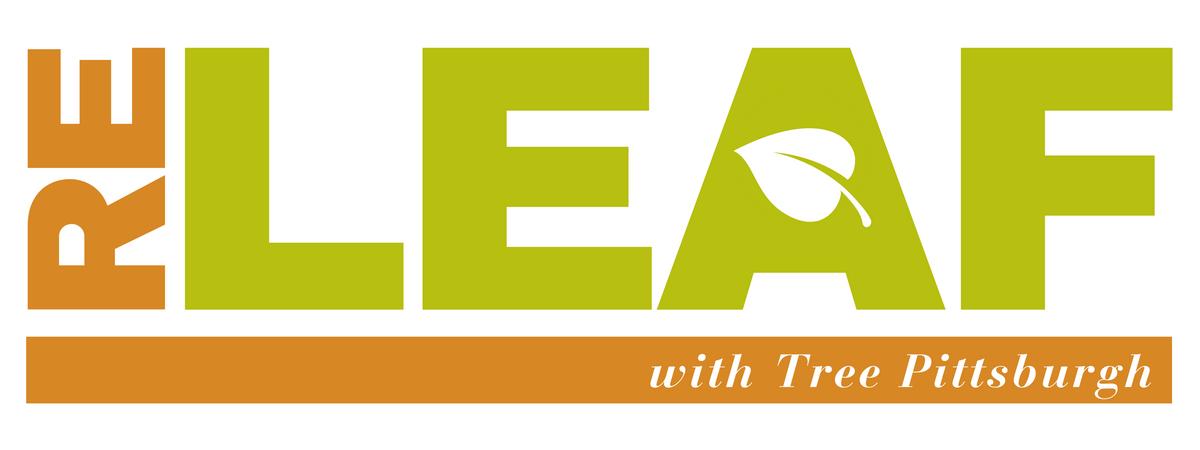



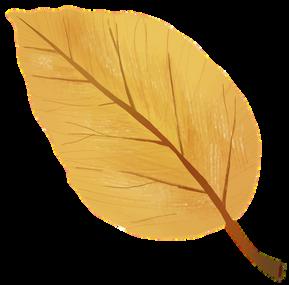








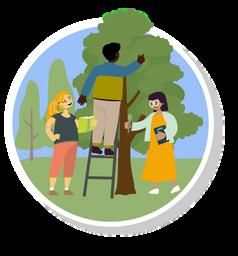
Greater Hazelwoood





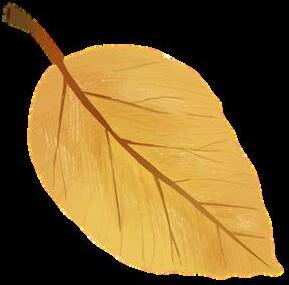
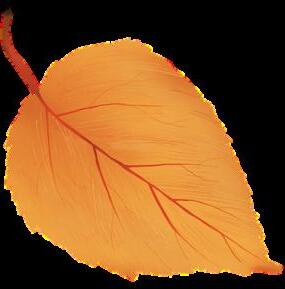





TABLEOF CONTENTS Acknowledgements What Do We Have? Executive Summary How Are We Doing? 2 5 3 21 How Do We Get There? What Do We Want? 18 10
A SPECIAL THANKS...
Thank you to all those that helped create and ignite the efforts of ReLeaf Greater Hazelwood While there were many folks that helped with the implementation and volunteer events we wish we could thank everyone, this list highlights some folks that helped chart the course of ReLeaf Greater Hazelwood


GREATER HAZELWOOD RESIDENTS CITY OF PITTSBURGH
Adrienne Jones
John Moore
Daniel Orkwis
Matt Peters
Elaine Price
Tiffany Taulton
Valerie Testa
Jon Ward
Gavin White
Lisa Ceoffe
ACKNOWLEDGEMENTS THANK YOU!
TREE PITTSBURGH
Matt Erb Kelsey Munsick
2
EXECUTIVE SUMMARY
FRAMEWORK
This plan recognizes that the relationship between trees, people, and places is essential Trees positively affect human health and are valuable assets to our community, providing us with many environmental, economic, and social benefits The goals and recommendations established in this plan will guide us to achieving our unified vision for Greater Hazelwood’s urban forest and are stretched beyond the basic tenants of the “Right Tree in the Right Place” concept. We must work together as partners in the urban forest to consider tree choices and locations in light of the overall benefits trees provide to a community, and how this can positively influence our city as a whole while making positive changes at the neighborhood level
RELEAF PLANNING PROCESS

This plan is a collaborative effort with community members and organizations, guided by Tree Pittsburgh. Tree Pittsburgh is a non-profit environmental organization dedicated to protecting and restoring Pittsburgh’s urban forest through community tree planting and care, education, and advocacy Tree Pittsburgh worked closely with a local steering committee to understand the opportunities and challenges within Greater Hazelwood The framework for the process was based on the process outlined below
THE RELEAF STEPS
What do we have?
The state of Greater Hazelwood's tree canopy and an overview of community resources.
What do we want?
Gathered public feedback that directed ReLeaf Greater Hazelwood's goals.
How do we get there?
Goals and recommendations based on the
What do we have and What do we want sections of ReLeaf Greater Hazelwood

How are we doing?
Monitoring and evaluation are keys to success for the implementation of this plan. This is the first comprehensive look back at the last 5 years to track success and opportunities

EXECUTIVE SUMMARY
3
RELEAF PLANNING PROCESS

Many of the recommendations in the 2012 City of Pittsburgh Urban Forest Master Plan (read the full plan at www.treepittsburgh.org) include increasing tree canopy in lower canopy neighborhoods through connecting and engaging the community. To better work with the unique challenges that exist in Pittsburgh's diverse neighborhoods, Tree Pittsburgh targeted neighborhoods to create an urban forest plan specific to the community’s needs and vision.
The Greater Hazelwood area is defined as Hazelwood and Glen Hazel The Greater Hazelwood Neighborhood Plan (read the full plan at https://pittsburghpa gov/dcp/ghnp) identifies needs that could benefit from increased trees. The Infrastructure section of the plan specifically mentions the need to improve air quality, improve public greenspaces, and decrease sewer overflow. Planting more trees would help to improve air quality, public greenspaces, and stormwater management
Greater Hazelwood serves as a transit corridor that ushers folks into the City of Pittsburgh Second Avenue is the main thoroughfare of Hazelwood and is a continuation of State Route 885. This heavily used highway through Hazelwood could benefit from trees to combat the exhaust of commuters’ vehicles and show visitors that there is an investment in tree equity in the neighborhood.
Greater Hazelwood plays a role in the larger scope of the ecosystem The ecological benefits of Greater Hazelwood’s trees expand to the Monongahela River Valley There are still active coke plants in the Monongahela River Valley, and Greater Hazelwood’s trees work to clean the air affected by this pollution Greater Hazelwood has a significant amount of greenspace in the Hazelwood Greenway; this asset provides many ecological benefits to the community and it is important to protect and grow these benefits. The growing threat of climate change is creating an even more urgent need to invest in the trees of Greater Hazelwood. Greater Hazelwood is prepared to help Pittsburgh work towards climate change goals by perpetuating the goals of ReLeaf Greater Hazelwood
EXECUTIVE SUMMARY 4
Hazelwood residents interact with our education team at a Tree Adoption event
WHAT DO WE HAVE?
Since 2005 the City of Pittsburgh, along with many partners, has been collecting valuable data on Pittsburgh’s urban forest. The following summarizes Greater Hazelwood’s urban forest through data obtained from Urban Tree Canopy Assessments in 2010 and 2015. Reviewing and analyzing the Urban Tree Canopy data is the first step in the goal-setting process. This allows stakeholders to understand the current state of the tree canopy and set goals for growing the urban forest.

Tree canopy is the collective coverage of trees in an area Greater Hazelwood’s tree canopy is comprised of a variety of parks, greenspaces, residential trees, and street trees Residents of Greater Hazelwood experience benefits from their tree canopy such as improved air quality and stormwater management These benefits expand beyond Greater Hazelwood to Pittsburgh’s urban forest

5 31.7% 31.1% 31.4% 44.59 acres 41.79 acres 66.4% 74.9% 75.6% 6.87 acres 5.08 acres 2010 2015 2020 2015-2020 Gain 2015-2020 Loss Greater Hazelwood Tree Canopy Change 2010–2020 HAZELWOOD GLEN HAZEL
WHATDOWE HAVE?
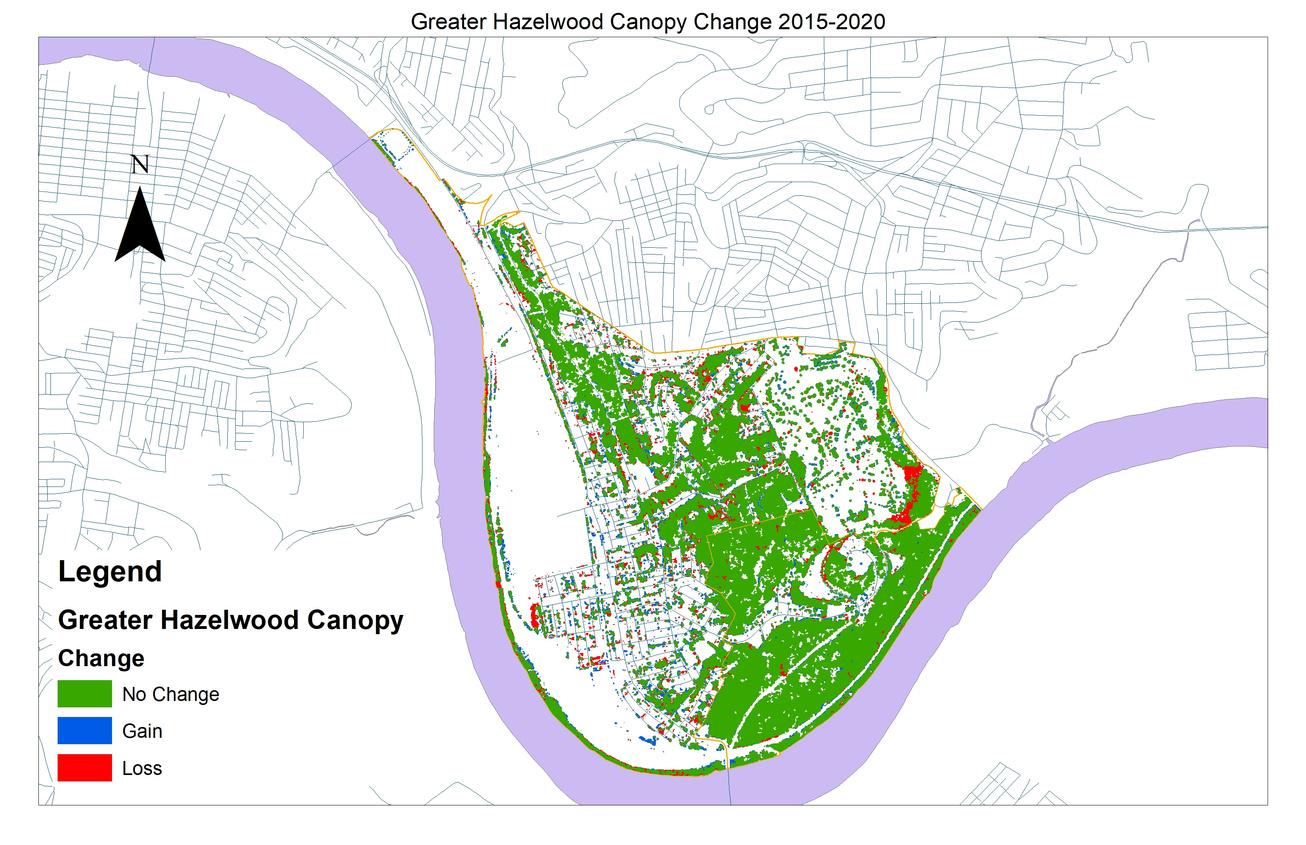
6
WHAT DO WE HAVE?
TREEVITALIZE TREES
TreeVitalize is a public-private partnership to help restore tree canopy coverage; educate citizens about planting trees as an act of caring for our environment; and build capacity among local governments to understand, protect, and restore their urban trees This partnership exists between the Allegheny County Parks, the City of Pittsburgh, Pennsylvania Department of Conservation and Natural Resources, Tree Pittsburgh, and the Western Pennsylvania Conservancy. Trees from the TreeVitalize program can be found along Second Avenue and at the entrance of the Hazelwood Greenway.
STREET TREES
Sidewalks in Greater Hazelwood connect the neighborhood by creating safe pathways across the comm sidewalks are often home to street trees ranging from newly planted trees to trees that have been aroun early years of the neighborhood. Newly planted trees follow standards to ensure that the right trees are right space These standards are used to ensure that as more trees are planted along sidewalks, there a negative impacts Historically trees planted along sidewalks have not been held to these standards resul upheaved sidewalks that are unsafe to use. This also creates issues for the homeowners, as it is their re maintain the sidewalk in the City of Pittsburgh. By following the standards and planting the right tree in t we can reduce the impact of trees planted along sidewalks while increasing canopy coverage around the
GREATER HAZELWOOD PARKS
Greater Hazelwood is home to neighborhood parks including Blair Street Park, Bud Hammer Playground Park, Elizabeth Street Park, Gladstone Field, Lytle Land, and Lewis Parklet These parks feature a variety amenities such as sports courts, a spray park, and playgrounds. Greater Hazelwood parks vary in their tr and are potential sites for future plantings. A recent addition to Greater Hazelwood parks includes a park from the Carnegie Library in 2021 Burgwin Park received 6 new balled and burlapped trees with the hel volunteers from POORLAW, and the youth football team the Hazelwood Cobras in 2022
GREATER HAZELWOOD GREENSPACES
The Community Garden on Chatsworth Street offers the community an opportunity to grow crops in a ra This community resource provides space for residents who may not have their own space to connect w The Community Garden is run by Hazelwood Initiative Other community gardens include Every Buddy’s Glen Hazel Garden, and the Victory Garden

WHAT DO WE HAVE?
7
Local volunteers dig into the Hazelwood Greenway to plant some new trees
The Hazelwood Greenway makes up a significant source of trees for the Greater Hazelwood area The Greenway is made up of parcels that are separated by residentowned lots and roadways These parcels span across Greater Hazelwood and are divided by Hazelwood Avenue. East Elizabeth Street provides access to the main trail through the Greenway. The Greenway is the site of the first planting project directly related to the Greater Hazelwood ReLeaf efforts In 2021, Hazelwood Initiative and the City of Pittsburgh’s Sustainability Planning Department lead the way with grant funding Meetings were held virtually and in person at the Hazelwood Greenway with Hazelwood Initiative, members of Pittsburgh’s Sustainability Planning Department, Tree Pittsburgh, Allegheny GoatScape, and Landforce to create a cohesive tree planting plan In the fall of 2021, 150 trees were planted by Tree Pittsburgh and Landforce to help shade out future invasive species. A second planting event was led by Tree Pittsburgh with volunteers from the Greater Hazelwood area to plant 20 additional trees in the Hazelwood Greenway to help return native species along the main trail 2022 welcomed three planting efforts Volunteers planted 89 trees at the Elizabeth Street Entrance to the Greenway. Allegheny Goatscape cleared two additional plots of invasives where 127 trees were planted Hazelwood Green is a 178-acre plot of land that was previously the site of the J&L Corporation steel mill. This multi-use site is still in development, but currently features a walking path, parking, office space, and public open space. Future plans include connecting the community to the riverfront through additional public open space Continued community meetings with developers are helping to shape this space from a historical site to a neighborhood hub.
Calvary Cemetery is a 200-acre plot on the north side of Hazelwood The cemetery is home to many trees but has experienced loss due to storm damage. The cemetery supported 27.87% tree canopy in 2010; that percentage dropped to 26.76% in 2015. The map to the right demonstrates the canopy change of Calvary Cemetery from 2010 to 2015
The Riverfront runs between Hazelwood Green and the Monongahela River, but access to the river is nonexistent Residents’ desire to restore access to the river is captured in the Greater Hazelwood Community Plan Despite the lack of access for residents, the riverfront provides a habitat for native species.

WHAT DO WE HAVE? 8
TREE ADOPTIONS
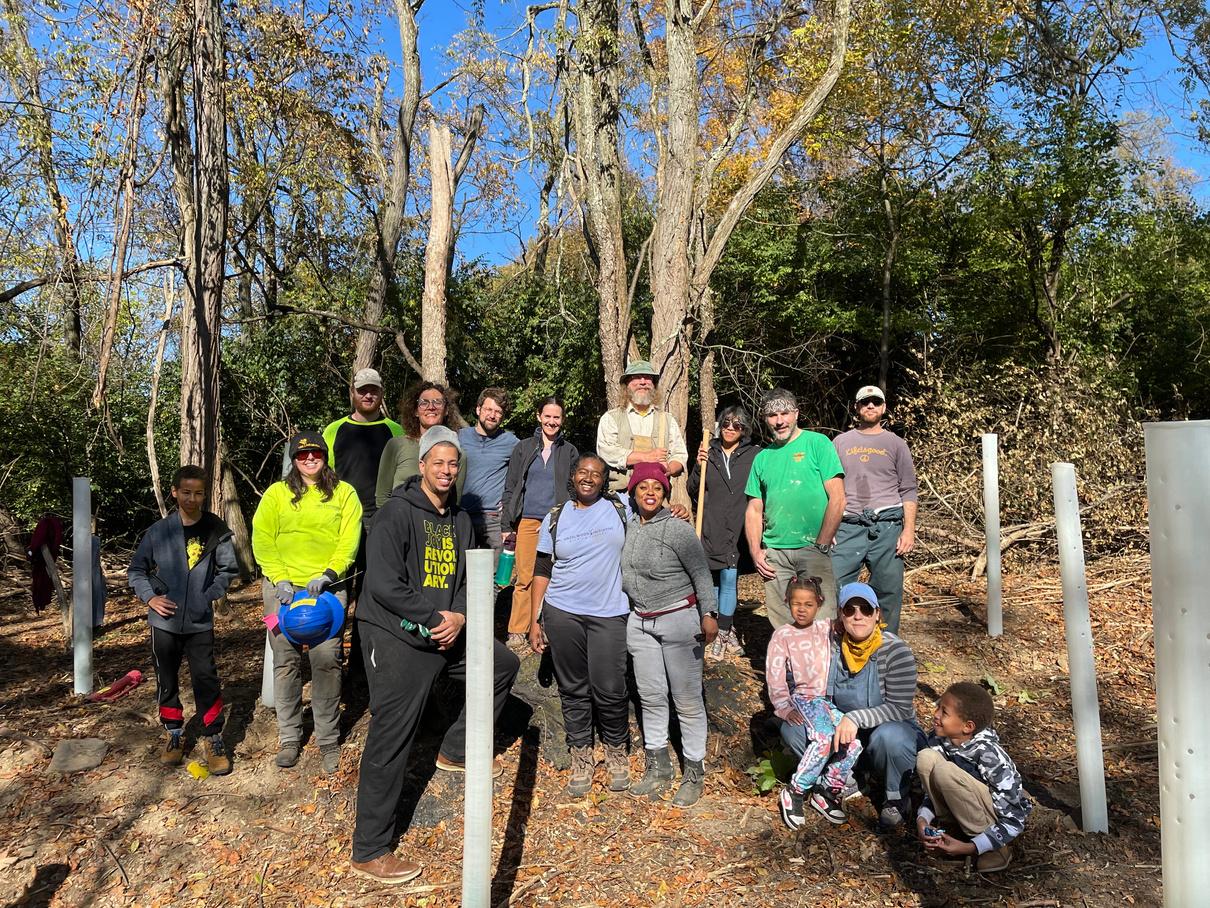
Greater Hazelwood hosted three tree adoption events in Hazelwood The first adoption event was held as a standalone event and 32 trees were adopted. The second event was held the weekend after Earth Day as part of a community celebration At this event, 117 trees were adopted A final adoption event was held Fall of 2022 where 95 trees were adopted These adoptions are valuable to the community as they allow homeowners to increase canopy coverage in their yards at no cost. Of the 261 trees adopted out, 212 went directly to Greater Hazelwood residents.
TREE TENDERS
Tree Tenders is a course offered by Tree Pittsburgh to certify and train residents in a variety of courses Course topics include tree planting, pruning, pest and diseases, and how to utilize TreeVitalize as a resource for trees in their community. Greater Hazelwood residents had the opportunity to take the course for free, as an effort to increase the number of Tree Tenders in the neighborhood The course was held virtually in 2021 As a result, there are 8 new Tree Tenders in the Greater Hazelwood area These new Tree Tenders will be instrumental in future tree care events and assisting at other community greening events.
VOLUNTEERING
There has been a strong volunteer presence since the implementation of ReLeaf Greater Hazelwood. Through various opportunities ranging from mulching parties to plantings, the time and efforts of these volunteers add up Volunteer support comes directly from the community and from surrounding areas The first year of ReLeaf Greater Hazelwood supported 14 hours of volunteer work. Volunteer efforts in 2022 increased to 56.5 hours. In addition to engaging local volunteers, a local nonprofit organization RIDC took an interest in working with Greater Hazelwood They worked to weed and mulch all of the trees surrounding the Three Rivers Village School in Hazelwood
WHAT DO WE HAVE?
9
Volunteers and Tree Pittsburgh staff gather for a group picture after a morning of planting trees
WHAT DO WE WANT?
The public outreach campaign played a critical role in understanding the needs and interests of Greater Hazelwood residents. Throughout this process, the public was integrated into many aspects to gather feedback and refine interests. Public engagement included community meetings, creating a localized steering committee to guide the process, and conducting a public survey to understand the neighborhood interests.

COMMUNITY MEETINGS
Greater Hazelwood had standing monthly community meetings to inform the neighborhood on projects and development throughout the neighborhood. These meetings are led by Hazelwood Initiative and community partners are invited to present A representative from Tree Pittsburgh attended those meetings to keep up on community developments and was invited to present at the start of ReLeaf to inform the community. Hazelwood Intiative would also periodically provide ReLeaf updates at these meetings.
STEERING COMMITTEE MEETINGS
Tree Pittsburgh hosted bimonthly Zoom meetings with the steering committee to gather input from community members. These meetings created a platform for communication between Tree Pittsburgh and Greater Hazelwood residents Representatives from Greater Hazelwood Initiative, Greater Hazelwood residents, and Tree Pittsburgh came together to form a steering committee to guide an internal review of the plan. The steering committee has been instrumental in guiding the process and giving input on opportunities and challenges Future meetings with the steering committee will be necessary to move recommendations and implementation forward
WWANT?

10
GREATER HAZELWOOD PUBLIC SURVEY
To further gather community feedback to guide ReLeaf plans, residents had the opportunity to respond to a public survey. To ensure accessibility, the public survey was distributed in a variety of ways. First, the survey was distributed door-to-door to allow direct feedback from community members. An online format was available for two months, and a phone option was available two days a week during the course of one month to provide residents with another way to participate in the survey In total, 246 citizens responded to the survey Of those who responded, 135 residents of the Greater Hazelwood area responded that there are not enough trees in Greater Hazelwood while 35 residents felt there were too many trees This survey was an excellent opportunity to gain both positive and negative feedback regarding Greater Hazelwood residents’ attitudes toward trees The following charts capture knowledge and understanding of the benefits of trees. Volunteer and educational opportunities surveyed included currently accessible community activities and opportunities that Tree Pittsburgh can bring to the community Activities that showed the highest levels of community interest will be considered for future engagement opportunities The benefits sections of the survey reflected the attitudes toward trees, the benefits they provide, and potential knowledge gaps regarding these benefits.
High response rates in the activities section highlighted community interest. Respondents indicated that they were most interested in planting a tree in the volunteering or recreational activity category while attending a tree identification walk was of the most interest in the educational activity category. Some residents could not participate in activities due to physical limitations and selected “ none of the above” in these cases The most striking takeaway from the Benefits section was that most residents did not know or did not understand the economic benefits that trees provide. Health and environmental benefits received over 100 responses of “Very Important” in every question In the economic benefits section “Very Important” only scored over 100 on two out of four questions. In the Economic benefits section, “Not Important” or “No Opinion” received higher responses from residents than the other two benefits section This demonstrates a knowledge gap and presented survey-takers with a learning experience. Overall, the public survey demonstrated mostly positive responses among some negative attitudes, which demonstrates the potential for further community education and engagement. The following pages show graphs to best illustrate the community's answers to the survey.
WHAT DO WE WANT? 11
A lot of trees are being cut down
How do you feel about the number of trees in Greater Hazelwood?
WHAT DO WE WANT?
There are too many trees
31% 24%
A lot of trees are dying
35.7% 9.3%
There aren't enough trees
12
What volunteer or recreational activities would you like to participate in?
15.4% Hike or snowshoe in the Hazelwood Greenway 14.4%
WHAT DO WE
13 Plant a tree 23% Attend a tree care day 21 3% Draw,
20.9%
WANT?
paint or photograph trees
Make art or flower arrangements from trees
None of these 5 1%
WHAT DO WE WANT? 14 Attend a tree ID walk 25.6% Attend a bird ID walk 19.8% Become a certified Tree Tender 19.4% Forage for food 15% Make medicine from trees 15% None of these 5.2%
educational activities
you like to participate in?
What
would
Trees provide many health benefits. How important are the following benefits to you?
Provides food
Filter out air pollutants
Reduce stress hormones & depression
Strengthen immune system & accelerate healing
Encourage walking and physical fitness
WHAT
15 Very Important Important Not Important No Opinion 0 50 100 150 200 250
DO WE WANT?
WHAT DO WE WANT? 16 Very Important Important Not Important No Opinion 0 50 100 150 200 250 Reduce utility bills Reduce crime Increase business foot traffic & sales Increase home value
provide many economic benefits. How important are the following benefits to you?
Trees
Trees provide many environmental benefits. How important are the following benefits to you?
Reduce carbon dioxide
Provide shade
Reduce storm water runoff
Reduce landslides
Provide wildlife habitat
WHAT DO WE WANT? 17
Important Important Not Important No Opinion 0 100 200 300
Very
HOW DO WE GET THERE?
eLeaf Greater Hazelwood is comprised of three major tegories, each with integrated outreach and maintenance forts. ReLeaf Greater Hazelwood includes programs focused on reet trees, public trees, and private trees.

PROGRAM VISION
ReLeaf Greater Hazelwood will be driven by an engaged and informed community and supported by non-profit organizations, city agencies, and private property owners. Greater Hazelwood’s urban forest will be better maintained to preserve current resources and will equitably grow through the celebration of diversity while emphasizing native species to increase the environmental, economic, and health benefits that trees provide for future generations
1
Provide a strategic vision to increase and enhance the current tree canopy throughout Greater Hazelwood
2.
HOWDOWE GETTHERE?
Encourage public participation in urban forest management through education and volunteerism.
Empower neighborhood organizations and citizens to move forward on projects and programs to increase, maintain, and protect trees
Promote species diversity and climate change tolerant species to ensure tree benefits for future generations through a sustainable planting program

Preserve existing and newly planted trees through tree maintenance education and tree care events and ensure tree benefits for future generations

18
A Hazelwood Tree Tender prunes a street tree along Second Avenue
3
Improve commuter walking and biking routes of Greater Hazelwood by using trees as traffic calming measures. Fight climate change and increase community resiliency through increased community greening efforts 5. 6
4.
7
PROGRAM GOALS
STREET TREES ACTION PLAN
Provide residents with information on sidewalk damage remediation
Manage current condition of street trees throughout Greater Hazelwood
Increase street trees through continued TreeVitalize applications
Host Mulching Parties and Pruning Workshops with Tree Pittsburgh
PUBLIC TREES ACTION PLAN
Plant fruit trees in the Chatsworth Community Garden
Plant trees in Gladstone Field
Plant trees in Bud Hammer Park
Host Tree Appreciation and Identification Walks
Increase school and library programming
PRIVATE TREES ACTION PLAN
Host Tree Adoption events in Hazelwood
Increase the number of Tree Tenders
Connect with church organizations to host plantings on church property
Connect with Propel School to host a planting on school grounds

HOW DO WE GET THERE?

19
1. 2 3. 4
1 2. 3
4. 5
1 2 3
4.
Youth from Greater Hazelwood help plant 6 new trees in Burgwin Park
CATEGORY BUDGET RESPONSIBILITY
Street Trees
TIMELINE RECOMMENDATIONS
Provide information on sidewalk damage remediation
Street
Manage current condition of street trees throughout Greater Hazelwood
Trees
Increase street trees through continued TreeVitalize applications
Trees
Host Pruning Workshop
Trees Public Trees Public Trees
Public Trees
Private Trees
Private Trees
Host Mulching Party Gladstone Field Planting
Host Tree Appreciation Walk
Increase school and library programming
Host tree adoption event in Hazelwood
Connect with church organizations to plant trees on-site
Ongoing Annually Ongoing Winter, Annually Annually Ongoing Annually Ongoing Ongoing Ongoing Ongoing $$ $$ $ $ $ $$ $ $$ $$ $$ $$
City of Pittsburgh, Tree Pittsburgh
City of Pittsburgh, Forestry Division
Neighborhood Volunteers, Hazelwood Initiative
Tree Tenders, Tree Pittsburgh
Neighborhood Volunteers, Tree Pittsburgh
Neighborhood Volunteers, Tree Pittsburgh Tree Pittsburgh
Tree Pittsburgh
Tree Pittsburgh
Neighborhood Volunteers, Tree Tenders, Tree Pittsburgh
Neighborhood Volunteers, Hazelwood Initiative
Street
Street
Connect with Propel School to host planting Street
Trees
Private Trees
20
GREATER HAZELWOOD RELEAF RECOMMENDATIONS
HOW DO WE GET THERE?
HOW ARE WE DOING?
From the Pittsburgh Urban Forest Master Plan, monitoring, analyzing, and revising are keystones toward keeping a dynamic management approach. A recommendation from the City-wide master plan is to prepare and distribute a “State of the Urban Forest” report to the public every 5 to 10 years. A formal plan revision will take place if any of the following changes occur (see figure below).

Tree Pittsburgh will conduct an assessment of the success of Greater Hazelwood’s ReLeaf program after its two-year plan Future plans outside of the two-year window will be led by the ReLeaf Greater Hazelwood steering committee with help from Tree Pittsburgh as funding provides. Reassessment will occur after two years to determine if the organized efforts are successful At that point, a complete evaluation and additional recommendations will be made to continue the ReLeaf Greater Hazelwood “How Are We Doing” section. This evaluation will assess metrics that will outline success and shortcomings
Tree Pittsburgh will include various metrics in an annual report, including but not limited to:
number of trees planted survival rates overall tree canopy cover change tree canopy cover changes by land type number of Tree Tenders number of trees pruned number of trees mulched and weeded assessment of annual tree benefits

Additionally, an annual report will be created to evaluate progress and inform the community about program successes To continue the coordination and momentum of the neighborhood-level effort, the steering committee will meet to work through opportunities and challenges as part of the standing Hazelwood Environmental Board meetings.


HOWARE WEDOING?
21










Tree Pittsburgh’s ReLeaf program is a stakeholder-driven process that brings urban forest planning to the neighborhood level We work with communities that want to chart a path toward a greener neighborhood Together, we’ll create a plan to grow the urban forest through tree planting, tree care, and education to help ensure long-term success 32 62ND STREET | PITTSBURGH, PA 15201 | (412) 781-TREE (8733) INFO@TREEPITTSBURGH.ORG















































